Exploring the Timeless Charm of 30 Famous Indian Handicrafts
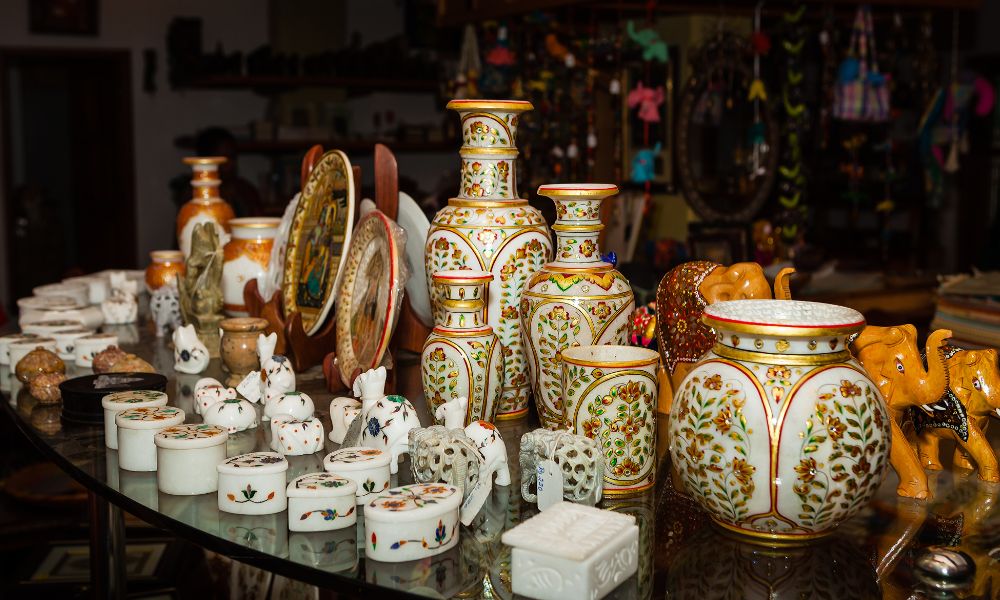
India is a land known for its rich cultural heritage and artistic traditions. From ancient times, Indian artisans have been creating exquisite handicrafts that showcase their craftsmanship, creativity, and deep-rooted traditions. These handicrafts reflect the diverse cultural landscape of the country, with each region having its unique art forms and techniques.
In this blog, we embark on a journey to explore the timeless charm of 30 famous Indian handicrafts. From the intricate embroidery of Lucknow’s Chikankari to the vibrant block prints of Rajasthan’s Ajrakh, we will delve into the history, significance, and artistic beauty of these masterpieces. Join us as we celebrate the artistry and cultural richness of India through its mesmerizing handicrafts.
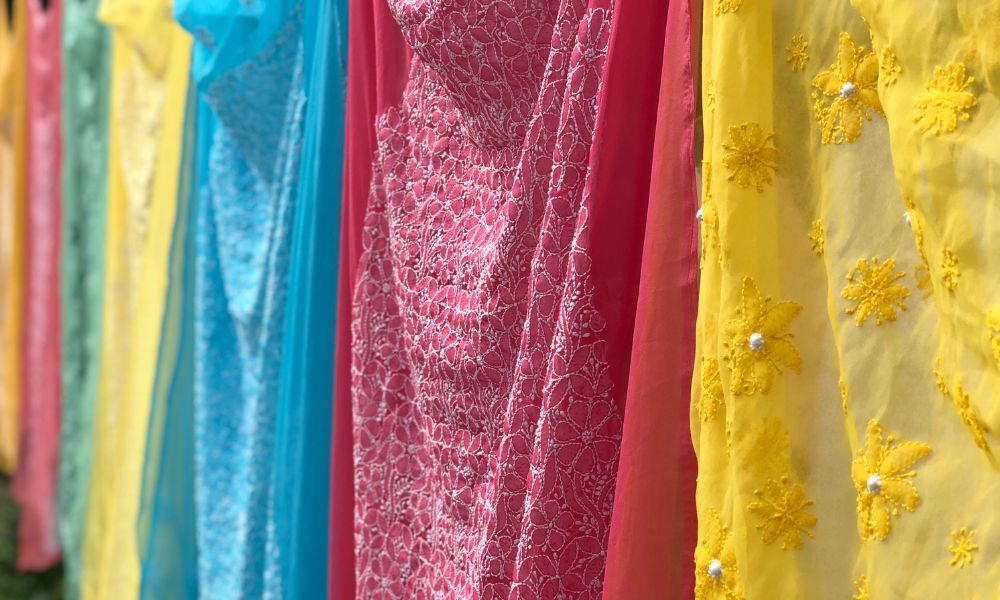
Chikankari Embroidery (Uttar Pradesh):
History: Chikankari is a traditional embroidery technique that originated in Lucknow, India. It is known for its delicate and intricate white threadwork on fine muslin fabric. The word “Chikankari” is derived from the Persian word “Chikan,” which means embroidery.
The origins of Chikankari can be traced back to the Mughal era in the 17th century. It was believed to have been introduced by Nur Jehan, the wife of Mughal Emperor Jahangir. Chikankari embroidery flourished under the patronage of the Mughal emperors and their noble families. The art form gained prominence during the reign of the Awadh Nawabs, particularly during the era of Nawab Asaf-ud-Daula.
Significance: Significantly, Chikankari is not merely a decorative art form but also a source of livelihood for many artisans in Lucknow and its surrounding areas. The embroidery is done entirely by hand, requiring immense skill, precision, and creativity. Each piece of Chikankari is unique and can take several days or even months to complete, depending on the complexity of the design.
Chikankari holds great cultural significance as it reflects the rich heritage and craftsmanship of Lucknow. It represents the fusion of Mughal and Persian artistic influences with indigenous Indian embroidery traditions. The art form has been passed down through generations, preserving the traditional techniques and motifs.
Over the years, Chikankari has gained international recognition and has become a symbol of Indian craftsmanship and elegance. It is widely used in creating exquisite garments like sarees, salwar suits, kurtas, and dupattas. Many renowned fashion designers incorporate Chikankari into their collections, showcasing its timeless beauty and versatility.
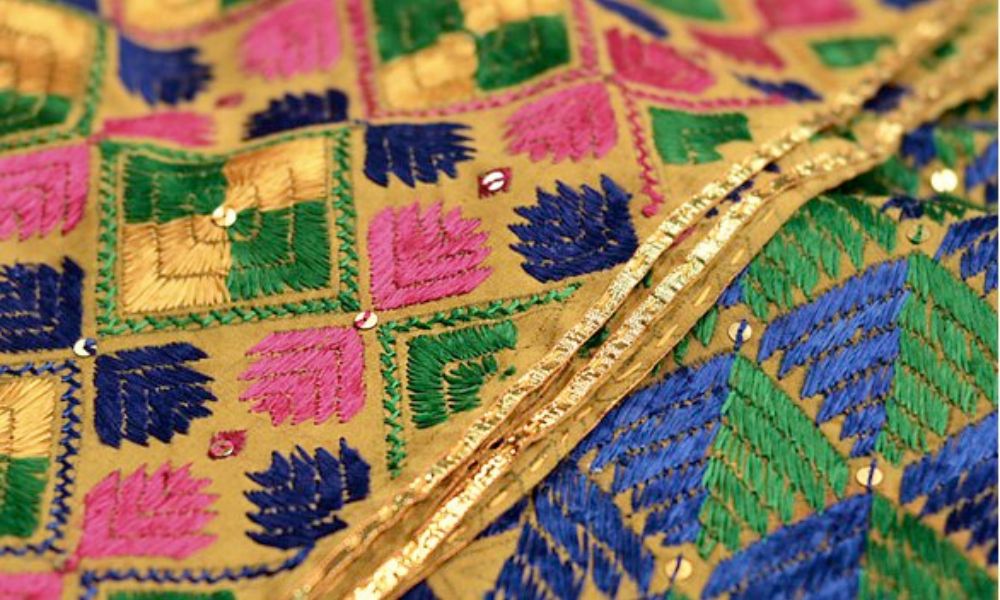
Phulkari Embroidery (Punjab):
History: Phulkari embroidery is a traditional embroidery technique that originated in the Punjab region, which spans across parts of India and Pakistan. “Phulkari” translates to “flower work” or “flower embroidery” in the Punjabi language. This vibrant and colorful art form has a long history and holds significant cultural and social importance.
The origins of Phulkari can be traced back several centuries. It is believed to have originated during the 15th century in rural Punjab. Phulkari embroidery was traditionally done by the women of Punjab, who would create these intricate designs as a form of self-expression and cultural identity. It was a common practice for women to embroider Phulkari shawls, scarves, and garments as a part of their trousseau, showcasing their skills and creativity.
Phulkari embroidery is characterized by its vibrant and bold use of colors. The designs primarily feature floral motifs, geometric patterns, and intricate stitches. The embroidery is done on a base fabric, which is usually a plain cotton or silk cloth. The motifs are created using a darning stitch called “phulkari stitch,” where the thread is drawn from the backside of the fabric, creating a distinct pattern on the front.
Significance: Phulkari holds great cultural and social significance in Punjab. It is considered an essential part of the region’s identity and heritage. The embroidery reflects the rich folk traditions and customs of Punjab and serves as a visual language through which stories, beliefs, and emotions are expressed. Phulkari is often associated with celebrations, festivals, and important life events like weddings.
Phulkari embroidery also has a symbolic significance. The vibrant colors and intricate patterns are believed to bring good luck, prosperity, and protection from evil spirits. Phulkari garments are often passed down through generations as heirlooms, carrying the history and memories of the family.
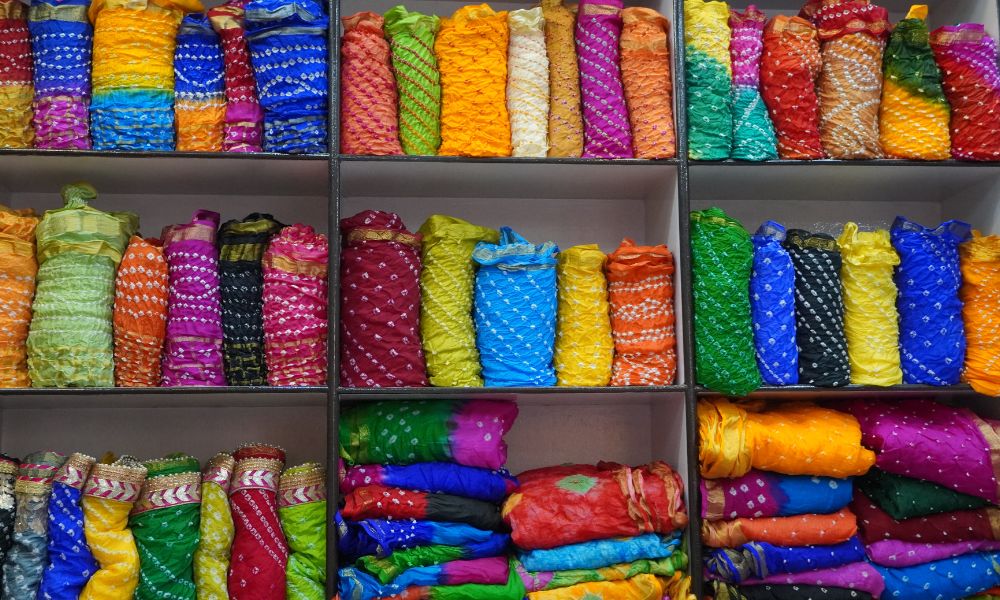
Bandhani Tie-Dye (Gujarat, Rajasthan):
History: Bandhani, also known as Bandhni or tie-dye, is a traditional textile dyeing technique that has its roots in the Indian subcontinent. The word “Bandhani” comes from the Sanskrit term “bandhana,” which means “to tie.” This ancient art form involves tying fabric in intricate patterns and then dyeing it to create beautiful and vibrant designs.
The history of Bandhani can be traced back over 5,000 years. It is believed to have originated in the region of Gujarat in western India. The art of Bandhani was practiced by various communities, including the Khatri community, who specialized in this intricate dyeing technique. Over time, Bandhani spread to other parts of India, including Rajasthan and Punjab, as well as neighboring countries like Pakistan.
Bandhani involves tying small portions of fabric with thread to create different patterns or designs. The tied areas resist the dye, resulting in a beautiful pattern when the fabric is dyed. Traditionally, natural dyes derived from plants and minerals were used to color the fabric. The most common colors used in Bandhani are vibrant shades of red, yellow, blue, and green. The technique allows for a range of patterns, including dots, waves, stripes, and geometric shapes.
Significance: Bandhani holds cultural and symbolic significance in many regions of India. It is closely associated with celebrations, festivals, and special occasions, such as weddings and religious ceremonies. Bandhani textiles are often considered auspicious and are worn to bring luck and prosperity. In some communities, Bandhani garments are passed down as heirlooms, representing the family’s traditions and heritage.
Bandhani also serves as a means of livelihood for many artisans and communities. The process of creating Bandhani textiles requires intricate handwork and skilled craftsmanship. Artisans spend hours meticulously tying and dyeing the fabric to achieve the desired patterns. This art form provides employment opportunities and sustains the livelihoods of numerous artisans, particularly women, who are often the primary practitioners of Bandhani.
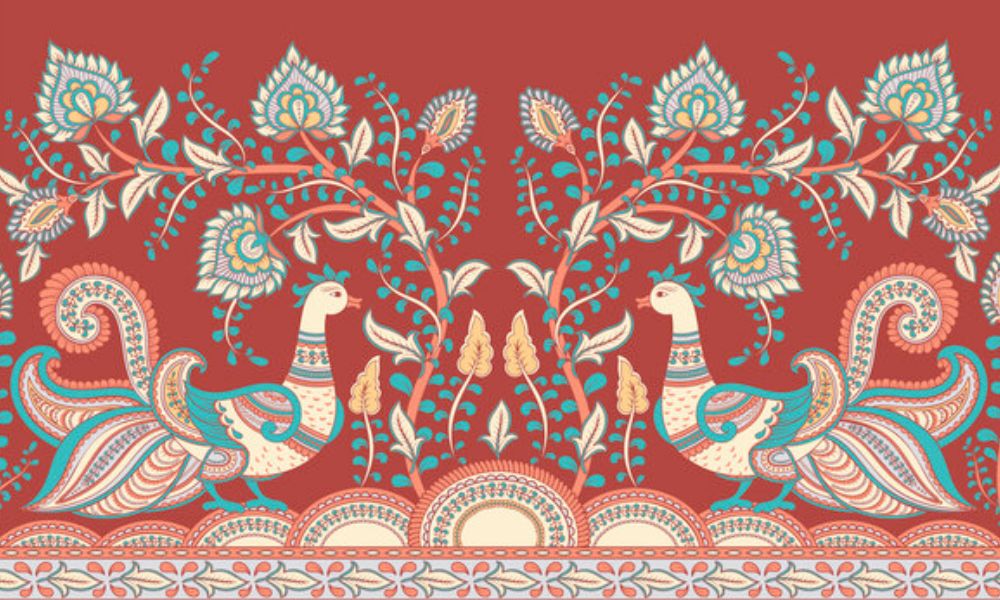
Kalamkari (Andhra Pradesh, Telangana):
History: Kalamkari is a traditional textile art form that originated in India. The word “Kalamkari” is derived from two Persian words: “kalam” meaning pen, and “kari” meaning work. It refers to the art of painting or printing on fabric using a pen or brush. The origins of Kalamkari can be traced back to ancient times, as early as the 10th century. It emerged in the regions of Andhra Pradesh and Telangana, in South India, particularly in the towns of Srikalahasti and Machilipatnam. Kalamkari was practiced by skilled artisans who used natural dyes and hand-drawn techniques to create intricate designs on textiles.
Kalamkari involves various stages and techniques. Initially, the fabric is treated to remove starch and impurities. Then, the outline of the design is drawn with a pen or brush using a mixture of water and black dye made from iron or gallnut. This process is known as “kalam.” The artists meticulously fill in the designs with vibrant natural dyes obtained from plants, roots, and minerals. This method is referred to as “kari.”
The themes and motifs depicted in Kalamkari art are diverse and often inspired by mythology, folklore, nature, and religious narratives. The designs can include intricate floral patterns, scenes from epics like the Ramayana and Mahabharata, and depictions of gods and goddesses. Each Kalamkari piece is a masterpiece of intricate detailing and storytelling.
Significance: Kalamkari holds significant cultural and artistic significance. It has been used traditionally to create storytelling textiles, depicting mythological tales and religious narratives. Kalamkari textiles were often used as wall hangings, temple decorations, and for ceremonial purposes. They were also highly valued as gifts and as a means of showcasing one’s social status.
Kalamkari is not just an art form but also a source of livelihood for many artisans. The intricate nature of Kalamkari requires skilled craftsmanship and expertise. It provides employment opportunities for numerous artists, who meticulously create these beautiful textiles, ensuring the preservation of the art form and the continuation of traditional skills.
In recent years, Kalamkari has gained recognition and popularity worldwide. It has been embraced by the fashion industry and incorporated into contemporary designs. Kalamkari fabrics are used in creating sarees, dupattas, dresses, stoles, and home furnishings. The unique and handcrafted nature of Kalamkari adds a touch of elegance and sophistication to these products.
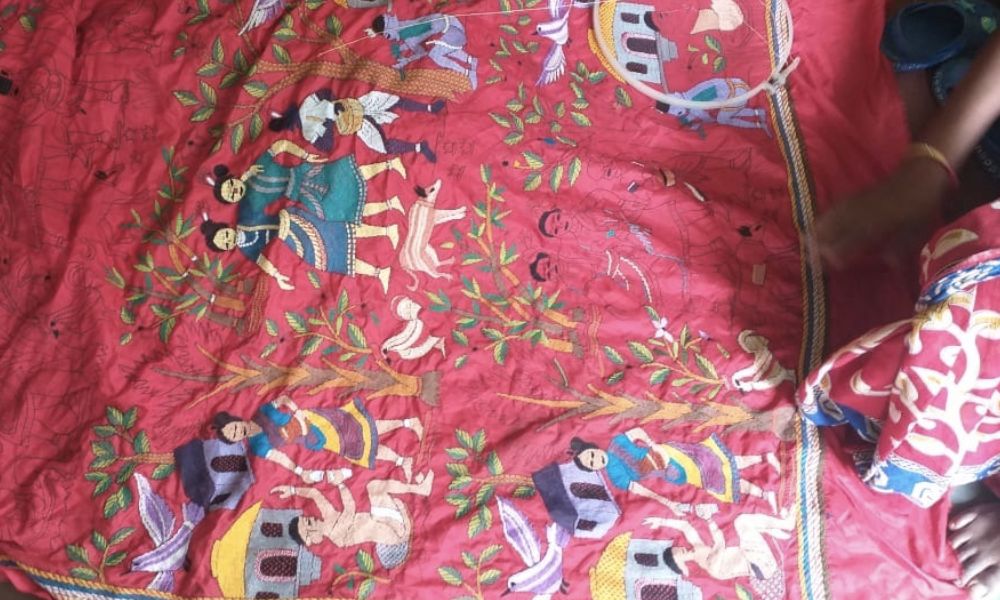
Kantha Embroidery (West Bengal):
History: “Kantha” refers to both the embroidery technique and the quilted fabric created through this art form.
The origins of Kantha embroidery can be traced back several centuries. It originated as a practical and creative way for women to reuse old fabrics and transform them into functional and beautiful textiles. Kantha was traditionally done by rural women, who would stitch together layers of old sarees, dhotis, or discarded fabric pieces to create quilts, blankets, and covers.
Kantha embroidery is characterized by its running stitch, known as “kantha stitch.” The embroidery is done by hand, where the artisan takes a long thread and weaves it through the fabric, creating intricate patterns and motifs. The stitches can be simple or elaborate, depending on the design and the level of detail desired. The most common motifs in Kantha embroidery are flowers, animals, birds, and geometric shapes.
Significance: Kantha embroidery holds cultural and symbolic significance. It is not only a form of artistic expression but also a means of storytelling and preserving traditions. Kantha quilts often depict narratives from mythology, folklore, and everyday life. They serve as a visual language, carrying the history, beliefs, and cultural identity of the community.
Kantha embroidery also has a practical aspect. The layers of fabric stitched together create a warm and lightweight textile, making Kantha quilts ideal for providing warmth during the winter season. In addition to quilts, Kantha embroidery is used to embellish a range of textiles, including sarees, dupattas, stoles, shawls, and home furnishings.
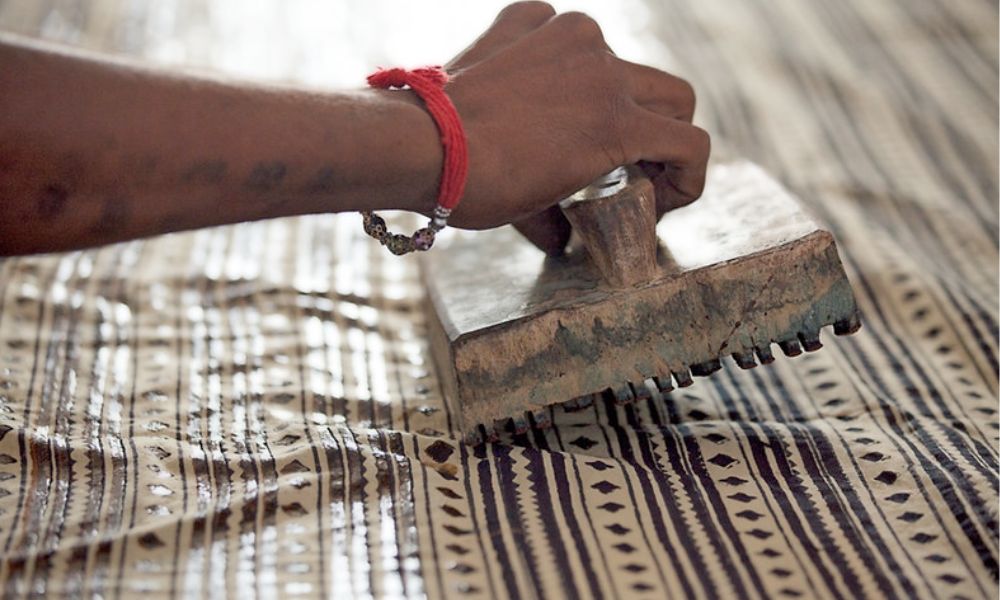
Ajrakh Block Printing (Gujarat, Rajasthan):
History: The word “Ajrakh” is derived from the Arabic word “Azrak,” which means indigo blue. Ajrakh block print is known for its intricate geometric patterns, vibrant colors, and the use of natural dyes.
The origins of Ajrakh block print can be traced back to the Indus Valley Civilization, dating back thousands of years. It is believed to have been practiced by the Khatri community, who migrated to the Kutch region from Sindh (now in Pakistan) during the partition of India. Ajrakh printing has been passed down through generations, with each artisan contributing their unique techniques and designs.
Ajrakh block print involves a complex and time-consuming process. The first step is to prepare the fabric, typically a natural fiber like cotton or silk. The fabric is washed and soaked in a mixture of clay, oil, and water to make it more receptive to dyes. The designs are then intricately hand-carved onto wooden blocks, which serve as the printing tools.
Natural dyes derived from plants, minerals, and other organic materials are used in Ajrakh block print. The primary colors used are indigo blue, red, black, and white. The fabric is printed with the carved blocks, using multiple rounds of dyeing and washing to achieve the desired colors and patterns. The repeated process of block printing and dyeing creates layers of intricate designs on both sides of the fabric.
Significance: Ajrakh block print holds significant cultural and historical significance. It is deeply rooted in the cultural heritage of the Kutch region. The geometric patterns and motifs used in Ajrakh printing often represent cosmic symbols, religious beliefs, and elements of nature. They are a reflection of the community’s identity, traditions, and connection to the environment.
Ajrakh block print is also known for its sustainability and eco-friendliness. The use of natural dyes and organic materials aligns with the principles of sustainable and ethical fashion. The artisans practice traditional techniques that have minimal impact on the environment, promoting a more conscious and responsible approach to textile production.
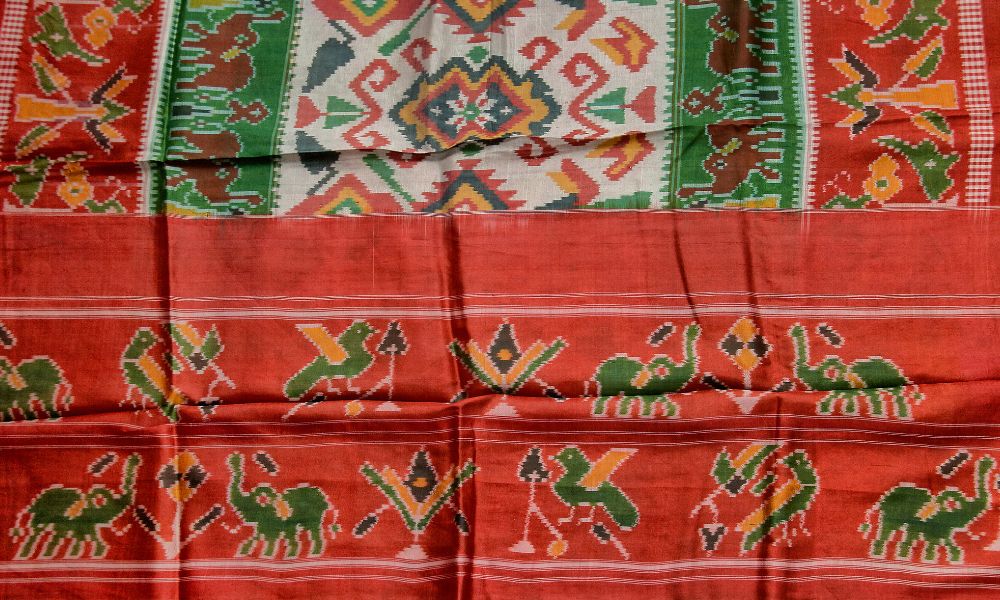
Patola Silk Weaving (Gujarat):
History: The word “Patola” is derived from the Sanskrit word “Pattakulla,” which means “woven cloth.” Patola silk weaving has a long and prestigious history and holds significant cultural and artistic importance.
The origins of Patola silk weaving can be traced back over several centuries. It is believed to have been practiced by the Salvi community, who were master weavers specialized in this art form. Patola silk sarees were considered a symbol of prestige, wealth, and social status among the affluent communities in Gujarat and neighboring regions.
Patola silk weaving is a complex and painstaking process. It involves the technique of double ikat, where both the warp and weft threads are tie-dyed before weaving. The design is carefully planned and meticulously tied and dyed on the warp and weft threads separately. The threads are then carefully aligned and woven on a handloom, creating intricate and symmetrical patterns on both sides of the fabric.
The motifs and patterns in Patola silk weaving are highly elaborate and often depict traditional and auspicious symbols such as flowers, animals, birds, geometric shapes, and religious motifs. The colors used are vibrant and rich, with red, green, yellow, and black being prominent. The precision and skill required to create the intricate patterns and align the dyed threads make Patola silk weaving a true art form.
Significance:
Patola silk weaving holds significant cultural and social significance. Historically, Patola silk sarees were worn by women on special occasions, festivals, and weddings. They were considered heirlooms and passed down through generations as a symbol of family heritage and tradition. Patola sarees were often seen as a precious investment, as their value would increase over time.
The revival and appreciation of Patola silk weaving have gained momentum in recent years. The intricate craftsmanship, cultural significance, and timeless beauty of Patola sarees have attracted attention from the fashion industry and collectors worldwide. Designers have incorporated Patola motifs and patterns into contemporary clothing, accessories, and home decor, blending traditional artistry with modern aesthetics.
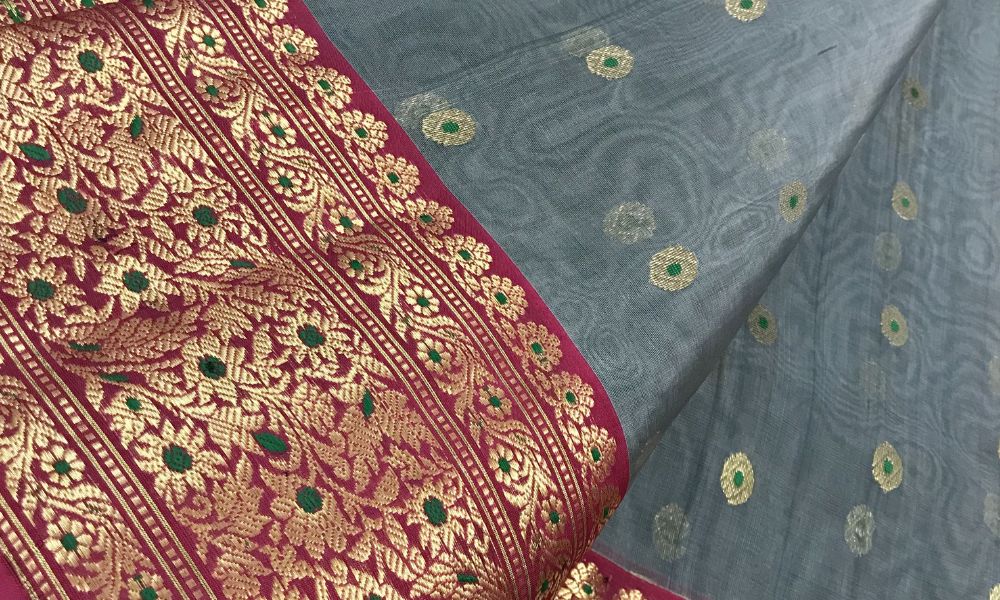
Chanderi Sarees (Madhya Pradesh):
History: Chanderi sarees are known for their sheer texture, lightweight feel, and intricate designs. They have a rich history and hold significant cultural and artistic importance.
The history of Chanderi sarees can be traced back to the Vedic period, around the 7th century. The art of weaving Chanderi sarees flourished under the patronage of various rulers, including the Scindias of Gwalior and the Holkars of Indore. Chanderi became a renowned center for textile weaving, attracting skilled weavers who mastered the art of creating these exquisite sarees.
Chanderi sarees are woven with a combination of silk, cotton, and zari (metallic thread). The unique feature of Chanderi fabric is its sheer texture, which is achieved by using a single flatured (single twisted) or double flatured (double twisted) yarn. The sarees are adorned with intricate designs, including traditional motifs like peacocks, flowers, geometric patterns, and gold or silver brocade borders.
Significance: Chanderi sarees hold significant cultural and historical significance. They are considered a symbol of elegance, grace, and sophistication. Chanderi sarees have been favored by royalty and worn on special occasions, weddings, and festivities. They are treasured as heirlooms and passed down through generations, representing the family’s heritage and tradition.
Chanderi sarees are also associated with the revival of traditional weaving techniques and the empowerment of artisans. The art of weaving Chanderi sarees has been traditionally practiced by skilled weavers, often working in small, family-run workshops. Efforts have been made to support and promote Chanderi weaving, providing training, improving infrastructure, and creating market access for the weavers.

Maheshwari Handloom (Madhya Pradesh):
History: The history of Maheshwari handloom dates back to the 18th century when it was revived under the patronage of Maharani Ahilyabai Holkar, the ruler of the Holkar dynasty. The craft was initially practiced by skilled weavers who migrated from Surat in Gujarat to Maheshwar. Under Maharani Ahilyabai’s support and encouragement, Maheshwari handloom flourished, and the town became a prominent center for textile weaving.
Maheshwari handloom sarees are woven with a blend of silk and cotton yarns, which gives them a unique texture and sheen. The fabric is lightweight, making it comfortable to wear, and it is characterized by its distinctive reversible border and pallu (end piece). The borders often feature intricate designs inspired by nature, such as flowers, birds, and peacocks, while the body of the saree displays delicate motifs and geometric patterns.
Significance: Maheshwari handloom holds significant cultural and historical significance. The craft represents the rich heritage of the region and showcases the skilled craftsmanship of the weavers. Maheshwari sarees have been favored by royalty and worn on special occasions, weddings, and festivals. They are treasured as heirlooms, passed down through generations, and celebrated as a symbol of elegance, grace, and cultural pride.
The revival and promotion of Maheshwari handloom have played a vital role in preserving traditional weaving techniques and empowering local artisans. Weaving Maheshwari sarees is a labor-intensive process that requires meticulous attention to detail and exceptional weaving skills. Efforts have been made to support the weavers by providing training, creating cooperatives, and establishing marketing platforms to ensure fair wages and sustainable livelihoods.

Tanjore Painting (Tamil Nadu):
History: The origins of Tanjore painting can be traced back to the 16th century during the reign of the Nayak dynasty. It flourished under the patronage of the Maratha rulers, especially King Serfoji II of Thanjavur, who played a vital role in promoting and refining the art form. Tanjore paintings were initially created as religious icons and offerings in temples, portraying gods, goddesses, and saints.
Tanjore paintings are distinguished by their characteristic features. They are typically created on wooden panels or boards, with a layer of cloth pasted over it to prevent cracks. The images are sketched on the base, and then, vibrant colors made from natural pigments and dyes are applied. The use of gold foil and precious stones, such as pearls and glass beads, is a prominent aspect of Tanjore paintings, adding a sense of opulence and grandeur.
The subjects of Tanjore paintings are often religious in nature, depicting deities from Hindu mythology, such as Lord Krishna, Goddess Lakshmi, and Lord Ganesha. The paintings aim to capture the divinity and spiritual essence of the depicted figures. The intricate detailing, bright colors, and use of gold foil give Tanjore paintings a distinct visual appeal.
Significance: Tanjore paintings hold significant cultural and religious significance. They are considered sacred art and play a vital role in Hindu religious practices. Tanjore paintings are not only decorative but also serve as objects of devotion and reverence. They are displayed in homes, temples, and shrines, serving as a means to connect with the divine and seek blessings.
The revival and appreciation of Tanjore painting have gained momentum in recent years. Artists and art enthusiasts have embraced this traditional art form, preserving its techniques and incorporating them into contemporary designs. Tanjore paintings have found a place in the art market, both within India and internationally, and are cherished as collectibles and pieces of artistry.
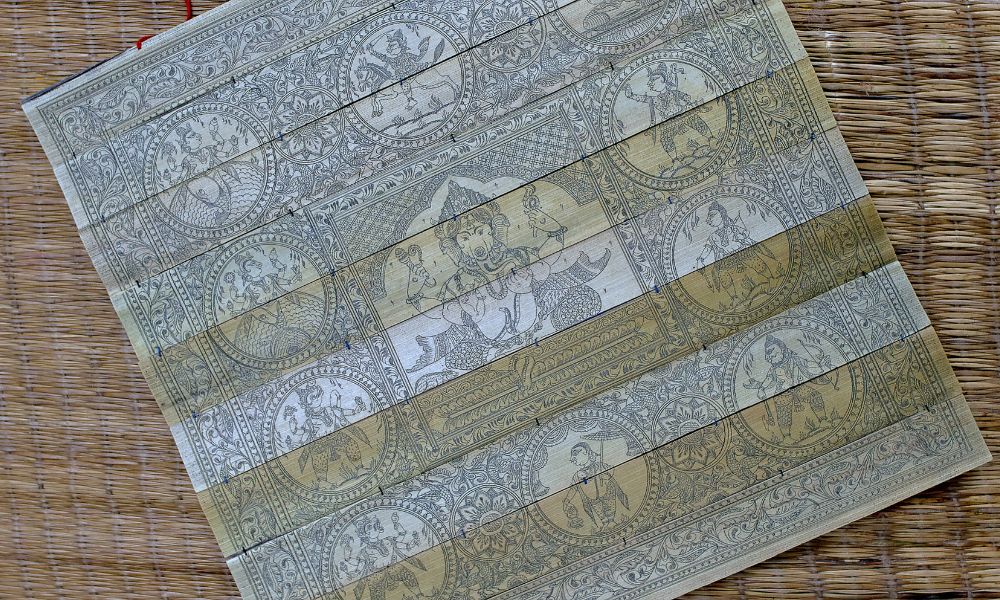
Pattachitra Painting (Odisha):
History: The origins of Pattachitra painting can be traced back to the 5th century AD, with references found in ancient texts and temple murals. It is believed to have evolved from the ancient art of mural painting. Pattachitra artists, known as Chitrakars, traditionally come from the Mahapatra and Moharana communities, who have passed down this art form through generations.
Pattachitra paintings are executed on cloth or specially prepared palm leaf manuscripts called “Talapatra.” The base material is carefully prepared by treating the surface with a mixture of chalk powder and gum made from tamarind seeds. The colors used in Pattachitra are derived from natural materials, such as earth pigments and mineral dyes.
The themes of Pattachitra paintings often revolve around mythological stories, religious deities, and folk tales. Popular subjects include Lord Jagannath, Lord Krishna, scenes from the Ramayana and Mahabharata, and depictions of village life. The paintings are characterized by intricate line work, fine brushwork, and the use of bold, contrasting colors.
Significance: Pattachitra painting holds significant cultural and religious significance. It is closely associated with the Jagannath cult and the annual Rath Yatra festival held in Puri, Odisha. Pattachitra artists create elaborate paintings of Lord Jagannath, his siblings, and the stories associated with the deities, which are used as part of the religious rituals during the festival.
Pattachitra paintings also serve as a means of storytelling and preserving cultural heritage. They are used to narrate mythological tales, folklore, and historical events. The paintings often convey moral and ethical messages, reflecting the values and beliefs of the community. Pattachitra art plays a crucial role in keeping these narratives alive and passing them on to future generations.

Meenakari Enamel Work (Rajasthan):
History: Meenakari enamel work, also known as Meenakari or Mina work, is a traditional form of decorative art that involves the application of vibrant enamel colors on metal surfaces. It has its roots in Persia and was later adopted and refined by artisans in India. Meenakari work holds a rich history and cultural significance as a highly skilled and intricate craft.
The history of Meenakari enamel work can be traced back to the Mughal era in the 16th century. It was introduced to India by Persian craftsmen during the reign of Emperor Akbar. The art form flourished under the patronage of the Mughal rulers, who admired its exquisite beauty and intricate detailing. Over time, Meenakari work became an integral part of Indian craftsmanship, particularly in regions like Rajasthan, Gujarat, and Varanasi.
Meenakari work involves the fusion of metalwork and the application of colored enamels. The metal surface, usually gold or silver, is first engraved, etched, or embossed with intricate patterns and designs. Then, the enamel colors, made from powdered minerals, are applied to the engraved areas. The piece is fired in a kiln at high temperatures, allowing the enamel to fuse with the metal and create a glossy, jewel-like finish.
Significance: Meenakari enamel work holds significant cultural and artistic importance. It is widely used in the creation of jewelry, decorative items, utensils, and religious artifacts. Meenakari jewelry, adorned with intricate enamel work, is particularly cherished as a symbol of beauty and craftsmanship. It is often worn on special occasions and weddings, reflecting the cultural traditions and the wearer’s social status.
Meenakari work also has religious significance, especially in Hindu and Islamic art. It is prominently used in the embellishment of temple domes, pillars, and doors. Meenakari artifacts are often associated with deities, and they play an essential role in religious rituals and ceremonies.
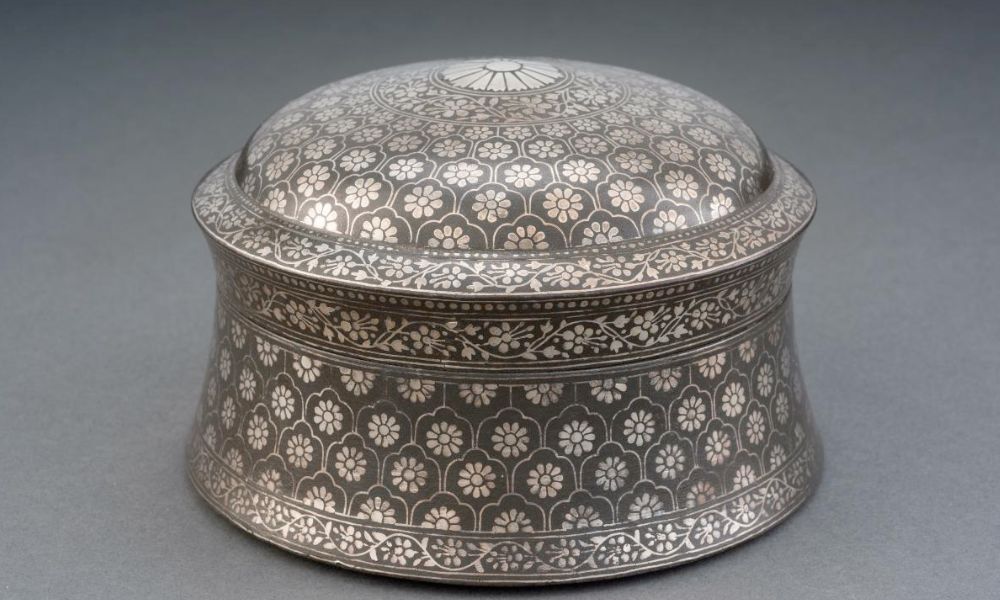
Bidriware Metalwork (Karnataka):
History: The history of Bidriware dates back to the 14th century when artisans from Iran brought their metalworking techniques to Bidar. Under the patronage of the Bahmani rulers, Bidriware flourished and became an integral part of the region’s artistic heritage. The craft reached its pinnacle during the rule of the Nizams of Hyderabad in the 18th century.
Bidriware is primarily created using an alloy of zinc and copper, which gives it a distinctive dark gray or black color. The metal is first cast into the desired shape, usually a vessel or an ornament. Then, intricate patterns and designs are engraved on the surface using chisels and hand tools. The engraved areas are filled with a fine paste made from silver or other contrasting metals.
The filled areas are then smoothed and polished, creating a striking contrast between the dark background and the shining silver inlay. The final step involves the application of a special soil mixture, known as “bidar soil,” which oxidizes the exposed metal and imparts the characteristic black color to the surface. The blackened metal serves as a backdrop for the intricate silver inlay work.
Significance: Bidriware holds significant cultural and artistic importance. It is widely appreciated as a symbol of fine craftsmanship and exquisite artistry. Bidriware articles, such as vases, boxes, trays, and jewelry, are highly prized for their aesthetic appeal and are often considered collector’s items.
Bidriware has received recognition as a Geographical Indication (GI) tag, highlighting its unique origin and cultural heritage. The craft has played a crucial role in preserving traditional metalworking techniques and providing employment opportunities for skilled artisans in the region.
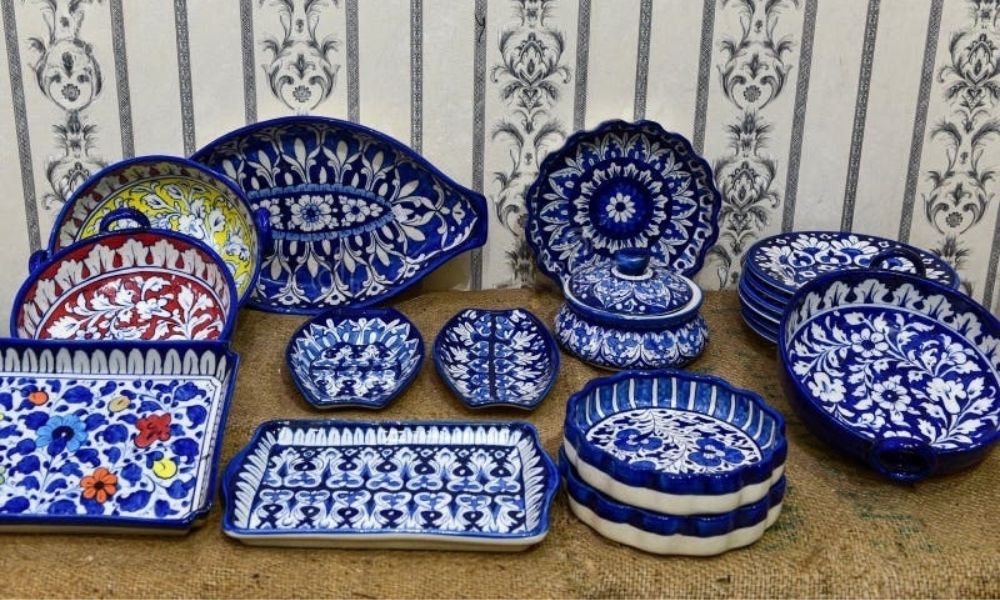
Blue Pottery (Rajasthan):
History: The history of blue pottery dates back several centuries. It is believed to have originated in the 9th century in Persia (present-day Iran) and later spread to Central Asia and India. It was during the Mughal era in the 14th century that blue pottery gained prominence in India, especially in the region of Jaipur, Rajasthan.
Blue pottery is created using a unique technique that involves the use of quartz and glass powder mixed with a white clay known as “Multani mitti.” The mixture is shaped into various forms, such as bowls, vases, tiles, and decorative pieces. The distinctive feature of blue pottery is the application of an intense blue color, obtained from cobalt oxide, over the white base.
The designs on blue pottery are intricate and often inspired by nature, such as floral motifs, birds, and geometric patterns. The intricate patterns are created by hand-painting or by impressing a patterned block onto the clay surface. After the initial firing, a transparent glaze is applied, which gives the pottery its characteristic glossy appearance.
Significance: Blue pottery holds significant cultural and artistic importance. It is highly valued for its aesthetic appeal, delicate craftsmanship, and unique color palette. Blue pottery pieces are considered exquisite decorative items and are often used as tableware, tiles, and decorative accents in homes and public spaces.
Blue pottery has become synonymous with the city of Jaipur in Rajasthan, India. It has played a vital role in the cultural identity of the region and has become an iconic craft associated with the city’s heritage. The craft has also contributed to the economic development of the region by providing employment opportunities for skilled artisans.
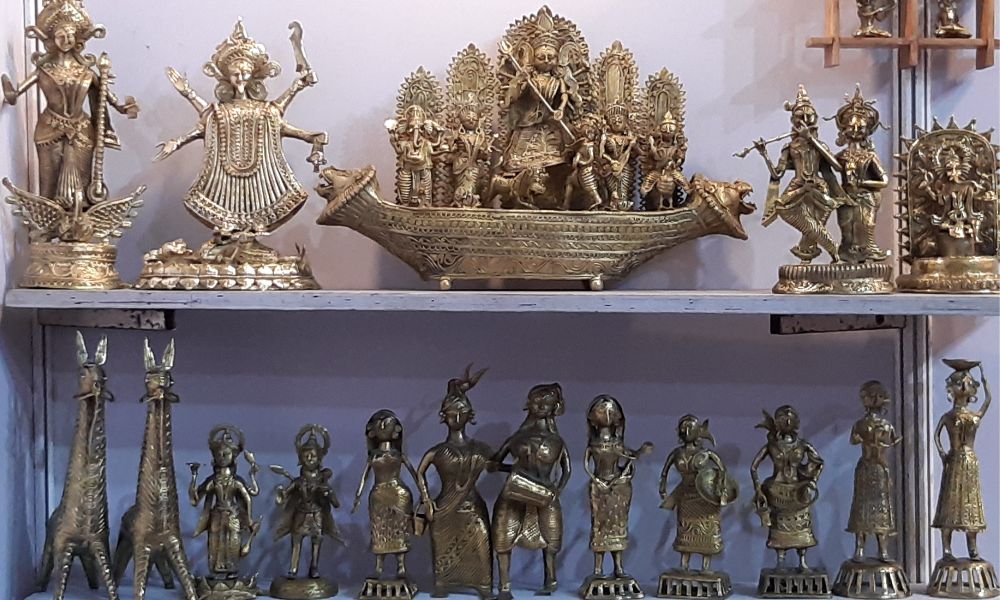
Dhokra Metal Casting (West Bengal, Odisha):
History: The history of Dhokra metal casting can be traced back over 4,000 years to the Indus Valley Civilization. The craft has been passed down through generations among the tribal communities, and it continues to be practiced today with the same ancient techniques. The name “Dhokra” is derived from the Dhokra Damar tribes, who are known for their expertise in this metal casting technique.
The process of Dhokra metal casting involves creating intricate patterns and designs using beeswax or a mixture of wax, resin, and nut oil. The wax is shaped and molded to create the desired form, including figurines, animals, jewelry, and other decorative objects. A clay mold is then made around the wax model and allowed to dry.
Once the mold is prepared, it is heated to melt the wax, which is drained out through small holes. The cavity left behind is then filled with molten metal, typically a combination of brass and bronze. The metal solidifies, and the clay mold is broken to reveal the final metal artwork. The surface is polished and sometimes given a unique patina or surface treatment to enhance its appearance.
Dhokra metal casting is characterized by its distinctive rustic charm and the use of organic forms and motifs inspired by nature. The artwork often depicts tribal life, animals, birds, and mythological figures. The intricate detailing and the imperfections in the metal casting process give Dhokra artifacts their unique and handmade appeal.
Significance: Dhokra metal casting holds significant cultural and artistic importance. It is deeply intertwined with the tribal communities’ cultural identity, reflecting their traditional beliefs, rituals, and way of life. Dhokra artifacts are considered sacred and are used in religious ceremonies, as well as for personal adornment and home decoration.
The craftsmanship and artistic skills involved in Dhokra metal casting have gained recognition both nationally and internationally. The revival and promotion of this ancient craft have contributed to the preservation of traditional art forms and the empowerment of tribal artisans. Dhokra metal casting showcases the rich cultural heritage of India’s tribal communities, celebrates their artistic legacy, and provides economic opportunities for the artisans and their communities.
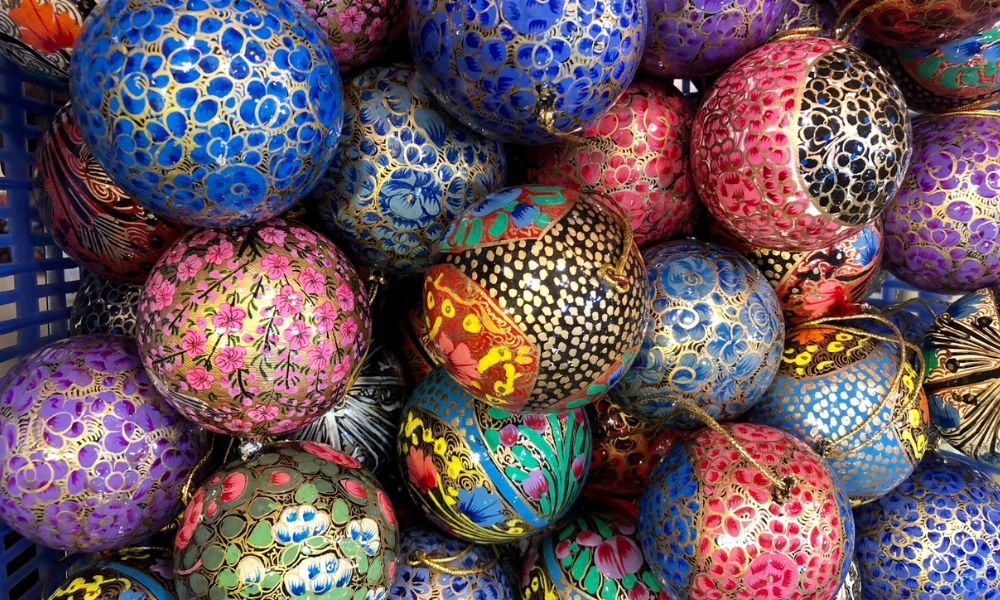
Papier-Mâché Craft (Kashmir):
History: Papier-mâché craft is a form of artistic expression that involves the use of paper and adhesive to create various objects and sculptures. It has a long history dating back to ancient Egypt, China, and Persia. Papier-mâché holds significant cultural and artistic importance as a versatile craft that allows for creativity and the production of lightweight yet durable artworks.
The origins of papier-mâché can be traced back to ancient times. The Egyptians used papyrus strips soaked in resin to create ornamental masks and funerary objects. In Persia, the craft flourished, with artisans creating intricate papier-mâché artifacts and decorative items. From there, the technique spread to other parts of the world, including China, India, Europe, and eventually to different cultures around the globe.
The term “papier-mâché” is of French origin, meaning “chewed paper.” It refers to the process of creating objects by layering paper strips with an adhesive, typically a mixture of glue, water, or flour paste. The paper is molded, shaped, or applied to a framework to form the desired structure. Once dried, it can be painted, varnished, or embellished with various decorative elements.
Papier-mâché craft allows for endless possibilities in terms of shapes, sizes, and artistic expression. It is widely used to create masks, puppets, figurines, bowls, vases, and other decorative objects. Its versatility and ease of manipulation make it a popular medium for both children and professional artists.
Significance: Papier-mâché holds significance not only for its artistic value but also for its accessibility and sustainability. It is an affordable craft that utilizes readily available materials, such as newspapers, cardboard, and glue. By recycling and repurposing paper, it promotes environmental consciousness and encourages creativity with minimal impact on natural resources.
Throughout history, papier-mâché has been used to create objects for various purposes. In different cultures, it has been employed in religious ceremonies, theatrical performances, and festivals. In Europe, particularly during the 18th and 19th centuries, papier-mâché gained popularity for making decorative items, furniture, and even architectural elements.
Papier-mâché craft continues to evolve and adapt to contemporary artistic trends. Artists and artisans experiment with new techniques, combining papier-mâché with other materials and incorporating modern designs and styles. The craft serves as a medium for self-expression, storytelling, and cultural preservation.

Terracotta Pottery (Uttar Pradesh, West Bengal):
History: Terracotta pottery is an ancient form of pottery that has been practiced by civilizations around the world for thousands of years. It holds significant historical and cultural importance as a versatile and enduring art form that showcases the creativity, craftsmanship, and connection with nature of various cultures throughout history.
The history of terracotta pottery can be traced back to the earliest civilizations, including ancient Mesopotamia, Egypt, Greece, and the Indus Valley. The term “terracotta” comes from the Italian words “terra” (meaning “earth”) and “cotta” (meaning “cooked”), referring to the process of firing clay to transform it into a durable material.
Terracotta pottery is made by shaping clay, usually sourced from riverbeds or other natural deposits, into desired forms such as vessels, sculptures, and architectural elements. The clay is then dried and fired in a kiln to harden it. The firing process gives terracotta its characteristic reddish-brown color, although variations in color can occur depending on the composition of the clay and firing techniques.
Significance: The significance of terracotta pottery lies in its multifaceted uses and cultural expressions. Throughout history, terracotta pottery has served practical purposes, such as storage containers, cooking vessels, and architectural elements like bricks and tiles. Its durability and insulating properties make it suitable for a wide range of applications.
Beyond its utilitarian functions, terracotta pottery holds immense artistic and cultural value. Various civilizations have used terracotta as a medium for artistic expression, creating intricate designs, sculptural forms, and decorative motifs. Terracotta sculptures have depicted mythological figures, religious symbols, human forms, animals, and everyday scenes, offering insights into the beliefs, traditions, and artistic sensibilities of different cultures.
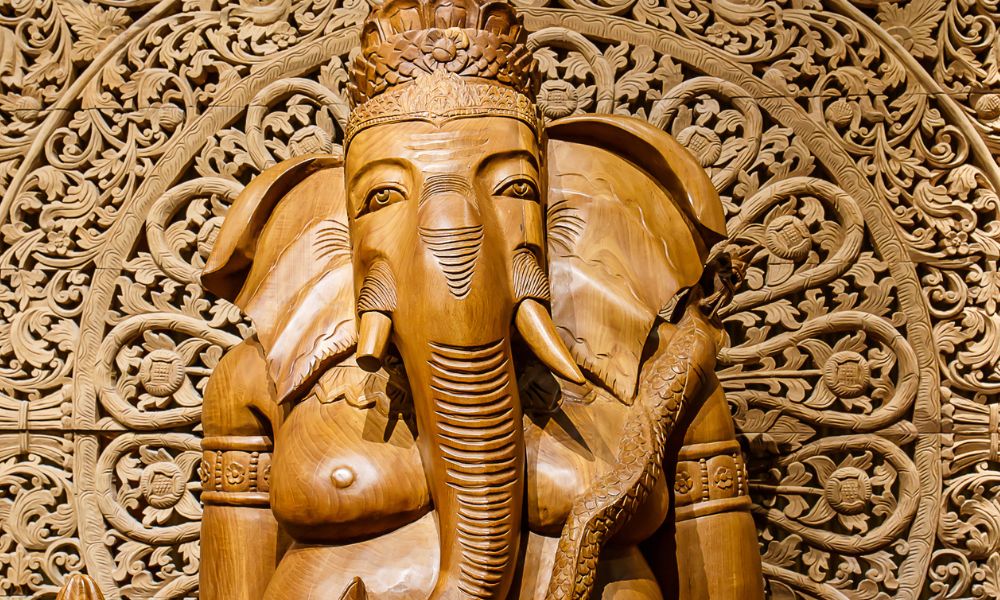
Wood Carving (Kerala, Rajasthan, Uttar Pradesh):
History: Wood carving is an ancient and highly esteemed form of artistic expression that involves the shaping and carving of wood to create intricate and detailed sculptures, decorative objects, and architectural elements. It has a rich history that spans across cultures and holds significant cultural, historical, and artistic significance.
The history of wood carving can be traced back thousands of years to prehistoric times when humans first began to shape wood using primitive tools. From the ancient civilizations of Egypt, Greece, and Rome to the intricate woodwork of medieval Europe and the ornate carvings of East Asia, wood carving has been practiced by diverse cultures around the world.
Wood carving techniques and styles have evolved over time, with different regions developing their unique artistic traditions. Skilled artisans have employed a variety of tools, including chisels, gouges, and knives, to meticulously carve wood into intricate designs, patterns, and sculptures. The choice of wood species, such as oak, mahogany, teak, and ebony, can also greatly influence the final appearance and quality of the carved piece.
Significance: The significance of wood carving lies in its multifaceted contributions to culture and art. Firstly, wood carving has been used to create religious and mythological sculptures, statues, and temple carvings. These elaborate wood carvings often depict deities, religious narratives, and spiritual symbols, serving as important religious and cultural icons.
Secondly, wood carving has been utilized in architecture to adorn buildings, furniture, and decorative elements. From intricately carved doors and window frames to exquisite furniture pieces and embellishments on buildings, wood carvings add beauty, craftsmanship, and architectural splendor to various structures.
Furthermore, wood carving has served practical purposes throughout history. It has been used to craft everyday objects such as utensils, tools, and household items. The skill of wood carving has been employed to create functional pieces that are both visually appealing and useful in daily life.

Marble Inlay Work (Agra, Rajasthan):
History: Marble inlay work, also known as Pietra Dura, is a decorative art form that involves the intricate inlay of semi-precious stones into marble surfaces. It has a rich history that dates back centuries and holds significant cultural and artistic significance as a craftsmanship that showcases the beauty and precision of stone inlay techniques.
The history of marble inlay work can be traced back to the ancient civilizations of Mesopotamia and Egypt, where stone inlay was used to adorn architectural structures and sculptures. However, it was during the Mughal era in India, particularly in the 17th century, that marble inlay work reached its peak and gained widespread recognition.
The Mughal emperors, such as Emperor Akbar and Shah Jahan, were great patrons of the arts, and they played a pivotal role in promoting and refining marble inlay work. Skilled artisans from Persia, Central Asia, and other parts of India were brought together to create exquisite pieces of art using this technique. The Taj Mahal, one of the most iconic architectural marvels in the world, is a stunning example of the beauty and intricacy of marble inlay work.
Marble inlay work involves the skillful placement of cut and polished semi-precious stones, such as lapis lazuli, malachite, coral, and mother-of-pearl, into the marble surface. The stones are meticulously shaped and fitted together to create intricate patterns, floral motifs, and geometric designs. The precision and attention to detail required in marble inlay work make it a time-consuming and labor-intensive process.
Significance: The significance of marble inlay work lies in its artistic and aesthetic appeal. The combination of the natural beauty of marble and the vibrant colors of the inlaid stones creates a visual spectacle. Marble inlay work is often associated with opulence, luxury, and grandeur, as it has been used to embellish palaces, tombs, temples, and other architectural marvels.
Marble inlay work also holds cultural and historical significance. It is deeply rooted in the artistic traditions of the Mughal era and represents a fusion of Persian, Central Asian, and Indian influences. The art form reflects the rich cultural exchange that occurred during that period and serves as a testimony to the skill and creativity of the artisans involved.
Furthermore, marble inlay work has provided economic opportunities for generations of artisans and has become an important craft in certain regions of India, such as Agra and Jaipur. The art form has been passed down through families, with knowledge and skills being preserved and refined over time. Today, marble inlay work continues to be a thriving industry, creating employment and sustaining the livelihoods of many artisans.

Gond Art (Madhya Pradesh):
History: Gond art is a traditional form of tribal art that originated from the Gond tribes of central India. It is characterized by its vibrant colors, intricate patterns, and depiction of nature and folklore. Gond art holds significant historical and cultural importance as a unique artistic expression that reflects the spiritual beliefs, cultural heritage, and close connection with nature of the Gond community.
The history of Gond art can be traced back to ancient times, with roots in the rich tribal traditions of the Gond tribes, who are among the largest indigenous communities in India. Traditionally, Gond art was practiced by both men and women as a means of storytelling and communication. The art form was passed down through generations, with each artist adding their own creative interpretations and techniques.
Gond art is primarily created using natural materials such as clay, charcoal, cow dung, and natural pigments. The artists use fine lines and dots to create intricate patterns that represent the interconnectedness of humans, animals, and nature. The motifs often include animals, birds, trees, and human figures, reflecting the Gond tribe’s deep spiritual beliefs and their harmonious relationship with the environment.
Significance: The significance of Gond art lies in its portrayal of the Gond community’s cultural heritage and worldview. The art form is deeply rooted in the Gond tribe’s mythology, folklore, and rituals. Each painting tells a story, capturing the essence of their daily lives, ancestral wisdom, and spiritual practices. Gond art is a way for the Gond people to preserve their traditions, pass down their knowledge, and celebrate their identity.
Gond art also serves as a means of economic empowerment for the Gond community. In recent years, Gond artists have gained recognition beyond their local communities, with their artworks being exhibited in galleries and art events worldwide. The popularity of Gond art has provided economic opportunities for the artists, enabling them to sustain their livelihoods while preserving their cultural heritage.
Gond art has transcended its traditional boundaries and has been adapted to various mediums, including canvas, paper, textiles, and even public murals. This adaptability has helped the art form reach a wider audience and contribute to the cultural diversity of contemporary Indian art.
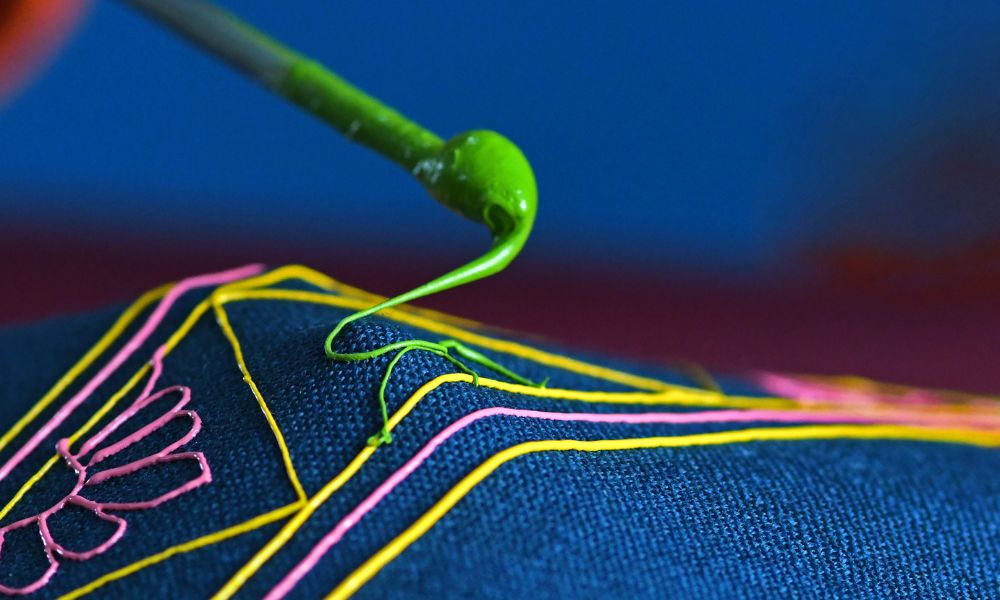
Rogan Painting (Gujarat):
History: Rogan painting is a unique and ancient art form that originated in the Kutch region of Gujarat, India. It is characterized by its intricate designs and vibrant colors created using a special type of paint made from castor oil. Rogan painting holds significant historical and cultural importance as a traditional craft that showcases the artistic skills and cultural heritage of the Kutch community.
The history of Rogan painting can be traced back over 300 years. It was introduced by the Khatri family of artisans, who were originally from Sindh, now in Pakistan, and migrated to the Kutch region. The word “Rogan” means “oil-based” in Persian, reflecting the primary ingredient used in the art form, which is a unique paint made from castor oil.
Rogan painting involves the use of a small metal rod or stylus called a “Rogan pin.” The artisan dips the pin into the castor oil paint and skillfully creates intricate patterns on a piece of cloth, typically silk or cotton. The designs often depict elements from nature, such as flowers, leaves, and birds, as well as geometric patterns and motifs inspired by local traditions and folklore.
The process of Rogan painting requires precision and expertise. The castor oil paint is thick and sticky, and the artisan carefully transfers the design onto the fabric by touching the rod to the cloth. This technique allows the paint to leave a fine and intricate trail, resulting in elaborate and highly detailed patterns.
Significance: Rogan painting holds cultural and artistic significance within the Kutch community. It is traditionally used to create decorative textiles, such as wall hangings, curtains, and garments, and is often associated with special occasions, weddings, and festivals. The intricate and vibrant designs of Rogan painting add a touch of elegance and beauty to the textiles, making them highly valued and cherished by the community.
Rogan painting is a time-consuming and labor-intensive art form. The knowledge and skills are passed down through generations within the Khatri community, ensuring the preservation of this traditional craft. However, due to the intricacies involved and the scarcity of skilled artisans, Rogan painting is considered a rare and endangered art form.
The significance of Rogan painting extends beyond its artistic value. It serves as a means of cultural expression and identity, as the designs often reflect the local traditions, stories, and beliefs of the Kutch community. The art form also provides economic opportunities for the artisans and helps sustain their livelihoods, contributing to the socio-economic development of the region.

Sujani Embroidery (Bihar):
History: Sujani embroidery is a traditional form of hand embroidery that originated in the state of Bihar, India. It is characterized by its intricate needlework and vibrant colors, and it holds significant historical and cultural significance as a craft deeply rooted in the traditions of rural Bihar.
The history of Sujani embroidery can be traced back several centuries. It has been traditionally practiced by women in rural communities, particularly among the Mithila and Bhojpur regions of Bihar. Sujani, which means “needlework” in Hindi, reflects the rich cultural heritage and artistic skills of the region.
Sujani embroidery is known for its intricate stitch work, which includes a combination of running stitch, chain stitch, satin stitch, and various other decorative stitches. The designs often depict elements inspired by nature, such as flowers, birds, animals, and geometric patterns. The colors used in Sujani embroidery are vibrant and eye-catching, reflecting the celebratory spirit and the cultural traditions of Bihar.
Historically, Sujani embroidery served both utilitarian and decorative purposes. Women would create Sujani quilts or bed covers using layers of fabric, stitching them together with colorful threads. These quilts provided warmth and comfort during the cold winter months. The intricate embroidery on the quilts also served as a form of artistic expression, showcasing the creativity and skills of the women who made them.
Significance: Sujani embroidery holds cultural and social significance within the communities of Bihar. It is often associated with important life events and celebrations, such as weddings and childbirth. Sujani quilts are considered valuable heirlooms and are often passed down through generations as symbols of love, care, and artistic heritage.
In recent years, Sujani embroidery has gained recognition beyond rural Bihar. Artisans and designers have embraced this traditional craft, incorporating it into contemporary fashion and home decor. The revival and promotion of Sujani embroidery have not only preserved a traditional art form but also provided economic opportunities for rural women, empowering them and promoting their skills.

Nirmal Paintings (Telangana):
History: Nirmal paintings are a traditional art form originating from the town of Nirmal in Telangana, India. With a history spanning over four centuries, this art form has deep cultural roots and showcases the artistic prowess of the region. Nirmal paintings are known for their intricate detailing, vibrant colors, and use of natural dyes. The themes often depict mythological stories, nature, and royal court scenes. These paintings are done on wooden panels, which are meticulously prepared and treated with natural materials to create a smooth surface.
Significance: Nirmal paintings showcase intricate floral and nature-inspired designs using natural dyes. They are painted on wood, reflecting the rich cultural heritage of Telangana. Nirmal paintings hold significant cultural and artistic value, preserving the heritage of Telangana and serving as a symbol of artistic excellence and craftsmanship.
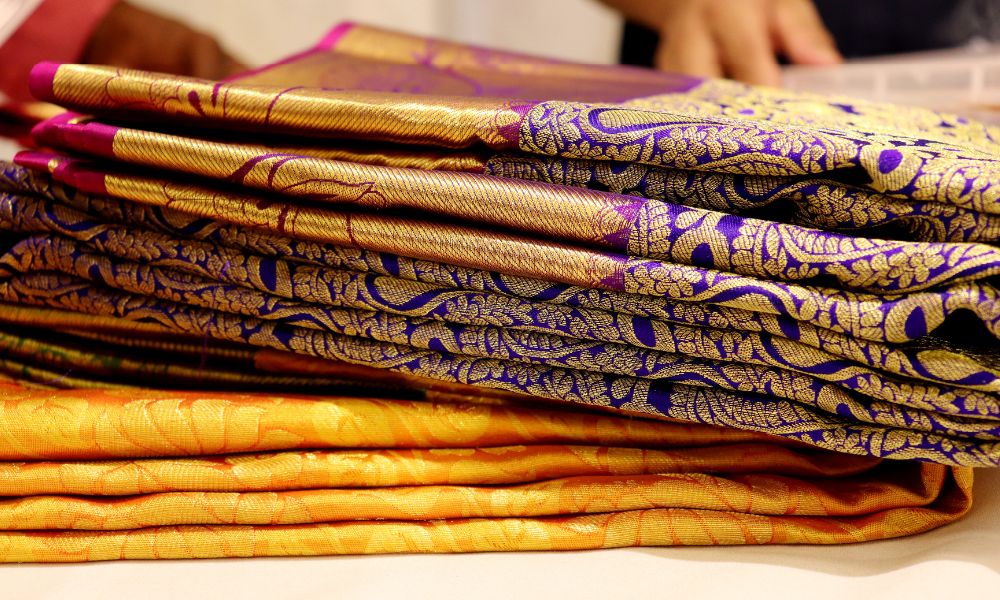
Banarasi Silk (Varanasi, U.P.):
History: Banarasi silk is a legendary textile that has captivated people for centuries with its exquisite craftsmanship and luxurious appeal. With a history rooted in the ancient city of Varanasi (also known as Banaras), Banarasi silk holds significant cultural and historical significance as one of India’s most revered traditional textiles.
The history of Banarasi silk can be traced back to the Mughal era when the art of weaving silk reached its zenith. It was during this time that skilled artisans from Persia migrated to Banaras and brought with them the knowledge and expertise of intricate weaving techniques. These artisans blended their Persian aesthetics with Indian motifs and designs, giving birth to the iconic Banarasi silk.
Banarasi silk is known for its opulence and intricate weaving. The fabric is made from high-quality silk threads, and the weaving process involves meticulous craftsmanship. The motifs and patterns woven into Banarasi silk are inspired by nature, such as flowers, leaves, and vines, as well as architectural elements like minarets and domes. These motifs are often woven using gold or silver zari threads, adding a touch of grandeur and richness to the fabric.
Significance: The significance of Banarasi silk goes beyond its sheer beauty. It has become synonymous with Indian weddings and is considered an integral part of bridal attire. Banarasi silk sarees, with their lustrous appearance and elaborate designs, are cherished heirlooms passed down through generations. Wearing a Banarasi silk saree on a special occasion is considered a mark of prestige and elegance.
Banarasi silk has also played a pivotal role in the economic growth of the region. Weaving Banarasi silk sarees is a time-consuming and labor-intensive process that requires the collective efforts of weavers, designers, and craftsmen. The weaving communities in Varanasi have kept this traditional art form alive, passing down their skills and knowledge from one generation to another. The intricate weaving patterns and designs of Banarasi silk have gained recognition worldwide, attracting both domestic and international markets.
Furthermore, Banarasi silk has been recognized as an important cultural heritage of India. In 2009, it was granted the Geographical Indication (GI) status, acknowledging its unique origin and traditional craftsmanship. This status ensures that only silk woven in and around Varanasi can be called “Banarasi silk,” protecting the authenticity and integrity of this ancient art form.
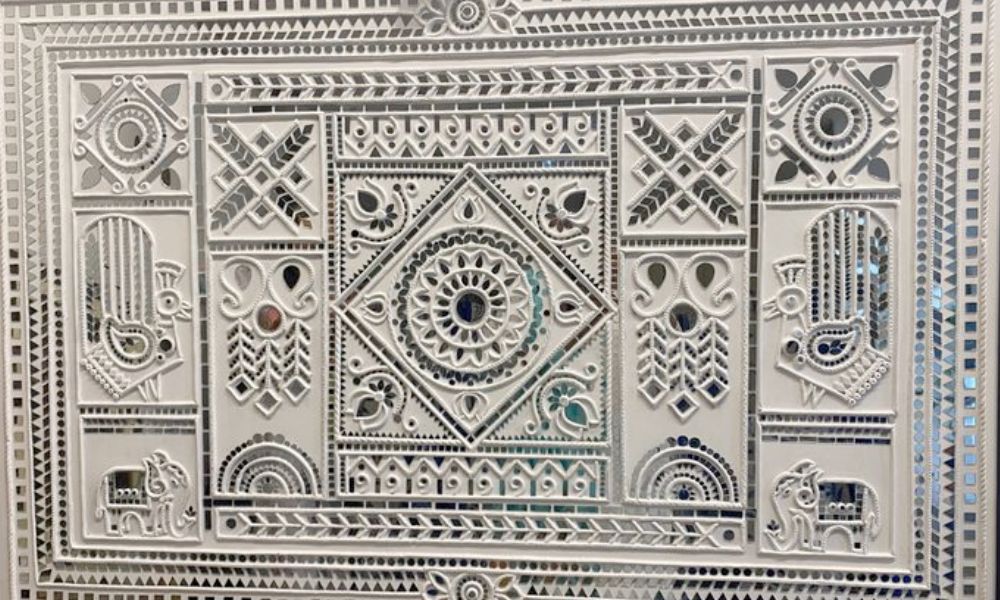
Lippan Art (Gujarat):
History: Lippan art is a traditional art form from Kutch, Gujarat, practiced by the Rabari community. Lippan art, also known as mud mirror work, is a traditional form of decorative wall art. This unique craft involves creating intricate patterns and designs using a mixture of clay and mirrors. Historically, Lippan art was used to adorn the interiors of mud houses, adding beauty and vibrancy to the simple dwellings. The reflective mirrors were believed to ward off evil spirits and bring positive energy into the living space.
Significance: Today, Lippan art has gained recognition as a distinctive folk art form, showcasing the craftsmanship and creativity of the artisans. It is a symbol of cultural identity and has become a popular form of home décor, representing the rich heritage of Gujarat. It is associated with the region’s architectural beauty and cultural traditions.
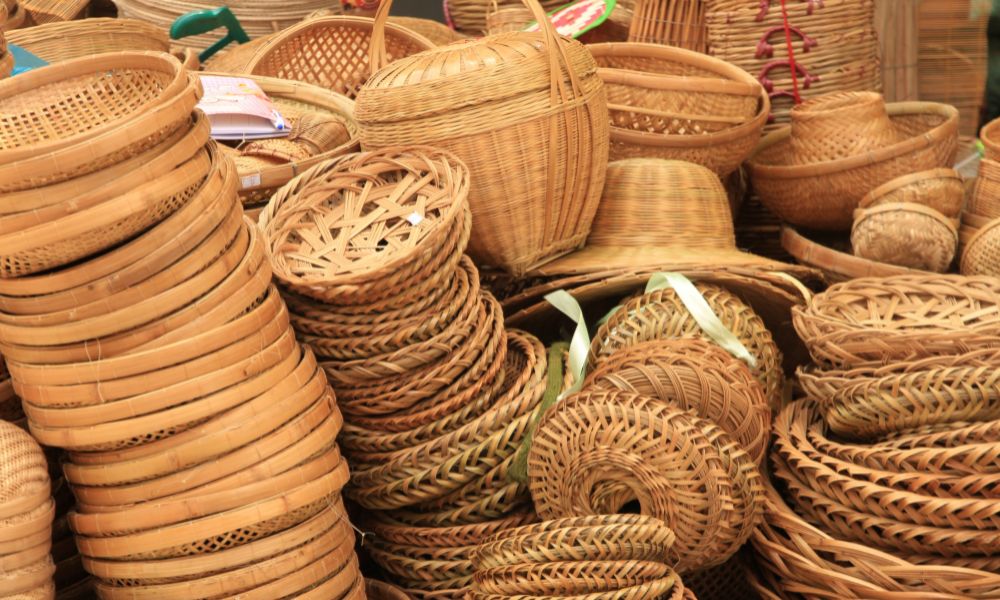
Cane and Bamboo Craft (Assam, Manipur, Tripura):
History: The cane and bamboo craft of eastern India has a rich history rooted in the region’s abundant natural resources. This traditional craft dates back centuries and is deeply intertwined with the lifestyle and culture of the local communities. Skilled artisans transform bamboo and cane into a wide range of products, including furniture, baskets, mats, and decorative items.
Significance: Artisans use cane and bamboo to create baskets, furniture, home decor items, and traditional musical instruments. The craft holds significant cultural and economic importance, providing livelihoods to numerous artisans and contributing to the local economy. Additionally, it showcases the sustainable use of natural materials and promotes eco-friendly practices. The intricately woven designs and durable nature of these creations have garnered recognition and appreciation both within India and internationally.
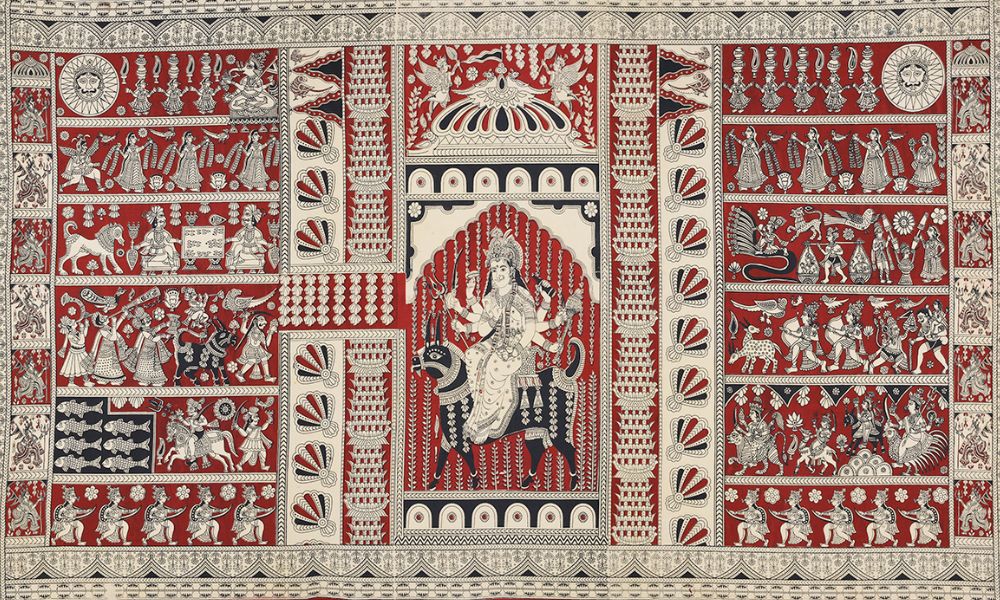
Mata ni Pachedi (Gujarat):
History: Mata ni Pachedi is a traditional art form that originated in Gujarat, India. “Mata ni Pachedi” translates to “Behind the Mother Goddess,” referring to the ritualistic backdrop used during the worship of Goddess Durga. Historically, it was created by the Vaghari community, who were originally nomadic and performed devotional practices.
Significance: Mata ni Pachedi involves hand-painted cloth depictions of Goddess Durga and other deities. It holds religious and cultural significance and is used during festivals and religious ceremonies. The paintings feature bold, intricate designs of the goddess and scenes from Hindu mythology. Mata ni Pachedi has great significance as a religious and cultural art form, serving as a portable temple and a means to connect with the divine. Today, it is cherished as a unique artistic expression and a symbol of Gujarat’s cultural heritage.
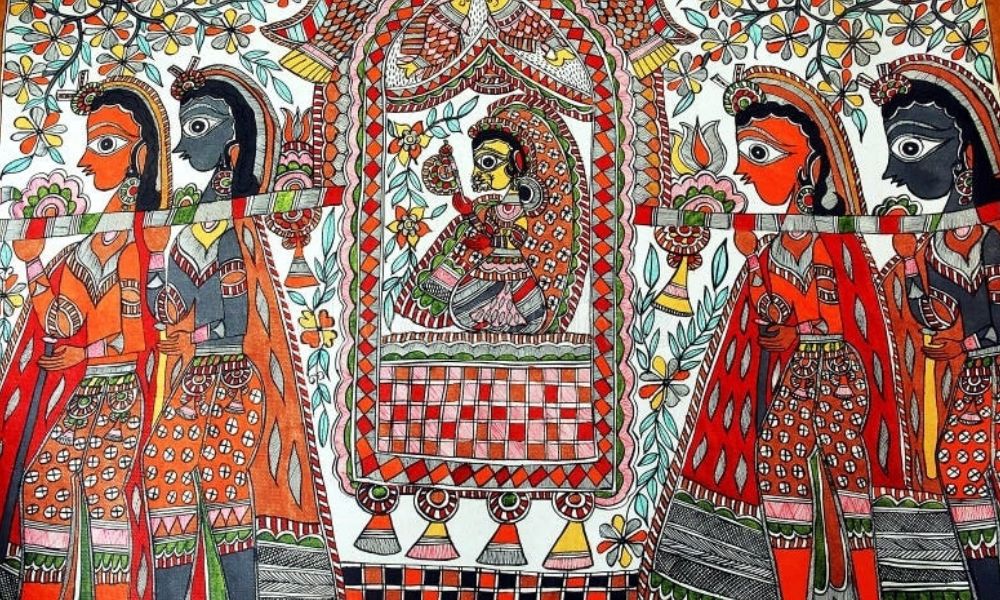
Madhubani Painting (Bihar):
History: Madhubani painting, also known as Mithila painting, is a traditional art form that originated in the Mithila region of Bihar, India. This art style has a rich history that dates back over 2,500 years. The name “Madhubani” is derived from two Hindi words: “Madhu,” which means honey, and “Ban,” which means forest. It is believed that the art form originated during the time of Ramayana, an ancient Hindu epic.
Madhubani paintings are deeply rooted in the local culture and customs of the Mithila region. Traditionally, these paintings were done by women from the local communities, and the themes of the paintings revolved around religious and mythological stories. The paintings were initially created on the walls of homes, huts, and temples, using natural dyes and pigments made from plants and minerals.
Significance: The significance of Madhubani painting lies in its cultural and social importance. It serves as a form of storytelling, conveying tales from Hindu mythology and local folklore. The paintings depict various deities, celestial beings, and scenes from religious texts, reflecting the spiritual beliefs and traditions of the community. Madhubani paintings also depict aspects of daily life, nature, and social issues, acting as a medium of expression and communication.
In recent years, Madhubani painting has gained international recognition and popularity. It has transcended its traditional boundaries and is now celebrated as a unique art form globally. Artists have adapted the style to create contemporary pieces, expanding the range of themes and techniques used in Madhubani painting. It has become a source of livelihood for many artists, providing economic empowerment and preserving the cultural heritage of the Mithila region.
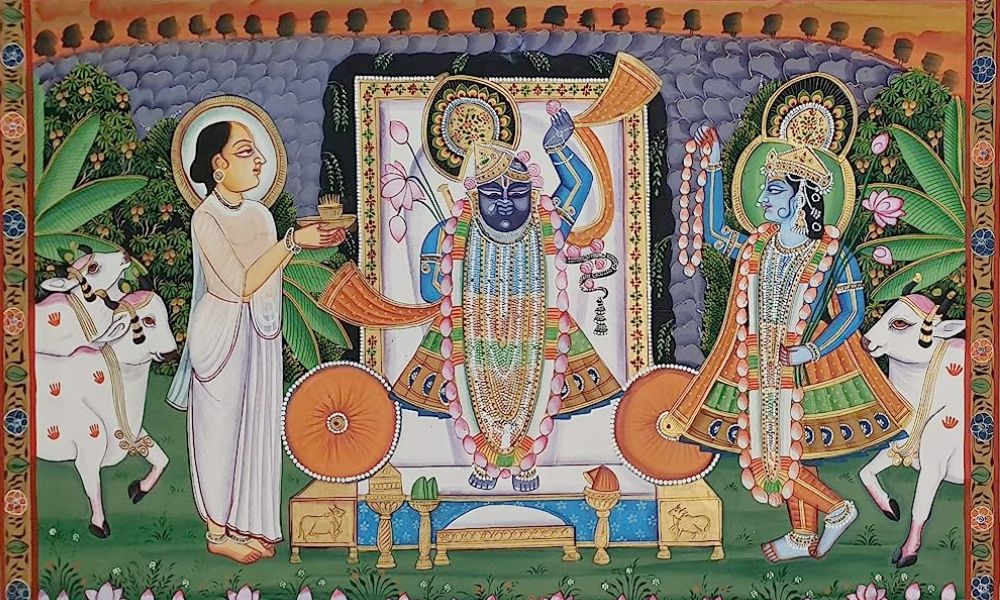
Pichwai Painting (Rajasthan):
History: Pichwai painting is a traditional art form that originated in the town of Nathdwara in Rajasthan, India. It holds a significant place in Indian art and culture, known for its intricate detailing, vibrant colors, and depictions of Lord Krishna and his life.
The history of Pichwai painting can be traced back to the 17th century when the Vallabhacharya sect of Vaishnavism was flourishing in the region. The followers of this sect, known as Pushtimargis, adorned the walls of the Nathdwara temple with large painted textiles (pichwais) as backdrops for the deity of Lord Krishna. These paintings were created to celebrate and depict various episodes from Krishna’s life, such as his childhood pastimes, his interactions with gopis (cowherd girls), and his divine Ras Leela (dance).
Pichwai paintings are traditionally made on cloth using natural pigments and dyes. The artists meticulously hand paint every detail, often using intricate brushwork and gold leaf embellishments. The subjects of the paintings are predominantly Lord Krishna, who is depicted in various moods, postures, and settings. The use of vibrant colors, such as blues, reds, and yellows, adds to the visual allure and captures the divine essence of Krishna’s stories.
Significance: The significance of Pichwai painting lies in its spiritual and cultural importance. These intricate artworks serve as a visual medium for devotees to express their devotion and adoration for Lord Krishna. Pichwai paintings are used as decorative backdrops in temples and are often displayed during festivals and religious ceremonies. They create an immersive and enchanting ambiance, transporting the viewers into the mystical world of Krishna’s leelas (divine plays).
Pichwai paintings also hold historical and artistic significance. They provide valuable insights into the cultural practices, religious beliefs, and social fabric of the era in which they were created. The level of detail in these paintings showcases the skill and craftsmanship of the artists who have dedicated themselves to preserving this traditional art form over generations.
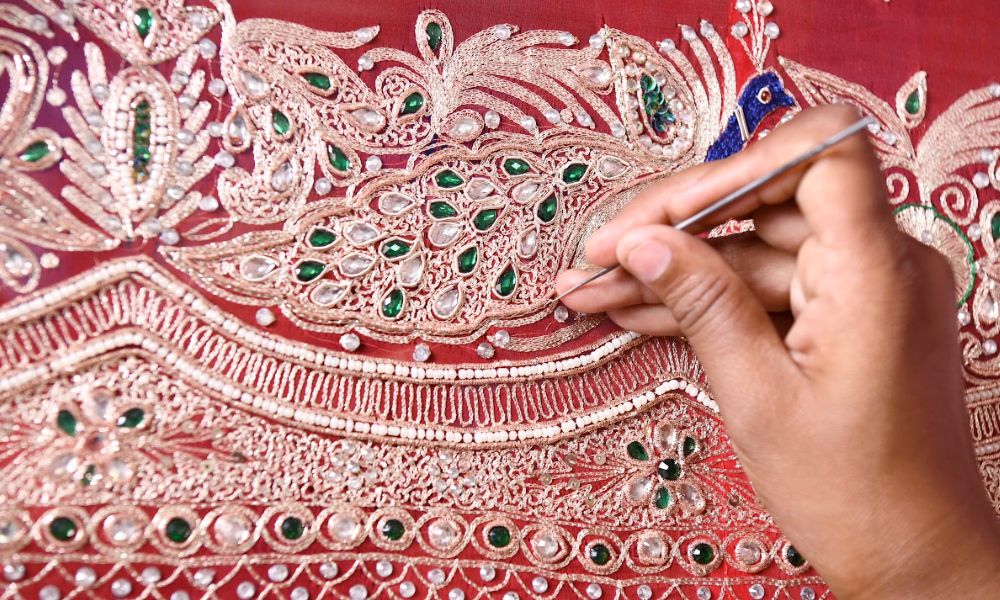
Zardozi Embroidery (Uttar Pradesh):
History: Zardozi embroidery is a magnificent and intricate form of embroidery that originated in ancient Persia and later found its way to the Indian subcontinent. The word “Zardozi” is derived from two Persian words: “Zar” meaning gold and “Dozi” meaning embroidery. As the name suggests, Zardozi embroidery involves the use of gold and silver threads along with precious stones, beads, and sequins to create lavish and ornate designs.
The history of Zardozi embroidery can be traced back to the Mughal era in India, where it flourished as a royal craft. It was initially patronized by the Mughal emperors and their courtiers as a symbol of wealth, luxury, and status. Skilled artisans were employed to create exquisite Zardozi embellishments on royal garments, accessories, and furnishings. Over time, Zardozi spread beyond the royal courts and became popular among the nobility and affluent classes.
Significance: The significance of Zardozi embroidery lies in its opulence, craftsmanship, and the rich cultural heritage it represents. Each Zardozi creation is a masterpiece of meticulous handwork, with artisans meticulously stitching fine threads and embellishments onto fabrics. The use of gold and silver threads adds a touch of grandeur and elegance to the designs. Zardozi embroidery is not just about the materials used; it is also about the skill and artistry involved in creating intricate motifs, floral patterns, and ornate borders.
In modern times, Zardozi embroidery continues to thrive as a revered art form, with artisans creating exquisite pieces for fashion, home décor, and luxury accessories. It not only preserves the heritage and cultural legacy but also provides employment opportunities to skilled craftsmen. The beauty and timelessness of Zardozi embroidery make it a cherished art form admired by people worldwide.
